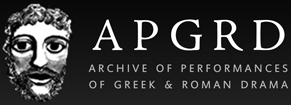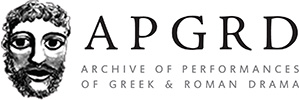We have run several workshops connected to the Translating Ancient Drama project. Giovanna Di Martino (UCL) and Estel Baudou (Lincoln) collaborated on a number of theatre workshops on early modern translations of ancient Greek tragedy with professional actors as well as on whole and fragmentary tragedy and epic with Oxford postgraduate students. Giovanna also collaborated with theatre director Marco Martinelli as a dramaturg on two workshops at UCL on early modern translations of Aristophanes' Wealth and will be working on Peace in October 2023 (Parma) and in October 2024 (London).
UCL: Early Modern Aristophanes in Performance II (February 2023)
- Director: Marco Martinelli, Teatro delle Albe; Dramaturg: Giovanna Di Martino
- Participants: Franklin Barron, Zoë Barros, Rosanna Beacock, Janina Corbet, Laura Cupellaro, Flora Grime, Indie Halstead, Josh Hobson, Emily Kerr, Sophie Kerr, Benedetto Loris Pizzo, Luna Malvaso, Aurora Monachesi, Zoë Perry Smith, Anna Rizzo, Lucy Ruddiman, Marta Szatkowska, Agnes Wilhelmsen.
- Performance Space: St George's Church Bloomsbury, Bloomsbury Way, London WC1A 2SA
- Texts: Ancient Script: Aristophanes, Plutus; Early Modern Scripts: Eufrosino Bonini, 1513: Commedia di Iustitia; Thomas Randolph and Francis Jacques, 1651: Ploutophthalmia ploutogamia: A pleasant comedie, entituled Hey for honesty, down with knavery; translated out of Aristophanes his Plutus, London; H. H. B. (H. H. Burnell?), 1659: The World’s Idol, Plutus a comedy, London
- Funding: the Widening International Didactics and Education Programme (w.i.d.e; 2022, Parma), the Classical Association, the Institute of Classical Studies, the Gilbert Trust Fund, UCL Institute of Advanced Studies, the APGRD, and the Leventis Foundation
Early Modern Aristophanes Research Output:
- A blog post including visual material is available on the UCL website
- A documentary and an edited version of the demonstration-performance by Lori Chen will be available soon.
- Forthcoming chapter by Giovanna Di Martino, Marco Martinelli, and Francesca Bortoletti in Memory and Performance: Classical Reception in Early Modern Festivals
UCL: Early Modern Aristophanes in Performance I (October 2022)
- Director: Marco Martinelli (Teatro delle Albe); Dramaturg: Giovanna Di Martino (UCL).
- Participants: Laura Cupellaro, Luna Malavaso, Aurora Monachesi, Benedetto Loris Pizzo, Anna Rizzo; Zoë Barros, Joshua Hobson, Victoria Rasbridge, Lucy Ruddiman, Marta Szatkowaska; Chiara Botti, Anna Calzolari, Lucia Davoli, Lucia Giusiano, Santiago Medioli, Giulio Robuschi, Shreeyukata Thapa, Maria Tonna; Pietro Bertoni, Eleonora Capitano, Camilla Di Felice, Margherita Galeotti, Marta Mitello, Carlo Mirra, Sara Odierno, Luca Zerbi.
- Texts: Ancient Script: Aristophanes, Plutus; Early Modern Scripts: Eufrosino Bonini, 1513: Commedia di Justitia, rinvenuta in un codice fiorentino e pubblicata nel 1986; Thomas Randolph e Francis Jacques, 1651: Ploutophthalmia ploutogamia: A pleasant comedie, entituled Hey for honesty, down with knavery; translated out of Aristophanes his Plutus, London.
- Funding: the Widening International Didactics and Education Programme (w.i.d.e; 2022, Parma), the APGRD, the Leventis Foundation.
Early Modern Aristophanes Research Output:
- Forthcoming chapter by Giovanna Di Martino, Marco Martinelli, and Francesca Bortoletti in Memory and Performance: Classical Reception in Early Modern Festivals
New Translational Paradigms and the ‘Rediscovery’ of Aeschylus - Prometheus Bound in Performance (June 2022)
- Director: Estel Baudou; Dramaturg: Giovanna Di Martino.
- Participants: James Aldred, Claire Barnes, Annaïg Briand, Cécile Dudouyt, Zoë Jennings, Laura Onate, Guia Mauri.
- Texts: Ancient Script: Aeschylus, Prometheus Bound; Early Modern Scripts: Jean-Jacques Lefranc de Pompignan, Prométhée enchaîné, in Tragédies d’Eschyle (1770); Robert Potter, Prometheus Bound (1777); Melchiorre Cesarotti, Prometeo (1754).
- Performance Space: Common Ground G11, IAS, UCL, London WC1A 2SA, at the conference Translating Ancient Greek Drama (1600-1800) at UCL on 24 June 2022, organised by Giovanna Di Martino (UCL) and Cécile Dudouyt (Paris 13).
- Funding: Leventis Foundation; University of Grenoble; Paris 13; APGRD.
New Translational Paradigms Research Output:
- A video of the demonstration-performance is available on YouTube: 18th Century Prometheuses in Performance.
- A Chapter by Baudou & Di Martino is forthcoming in Di Martino-Dudouyt, Translating Ancient Greek Drama (1600-1800), De Gruyter (Berlin: 2024).
Early Modern Iphigenias in Performance II (May 2021)
- Director: Estel Baudou; Dramaturg: Giovanna Di Martino
- Participants: James Aldred, Claire Barnes, Giovanna Di Martino, Zoë Jennings, Lara Korach, Philippa Lang, Guia Mauri and Chuan Yue
- Performance Space: Oxford Friends Meeting House, 43 St Giles', Oxford OX1 3LW
- Text(s): Ancient script: Euripides, Iphigenia at Aulis; Early Modern Scripts: Thomas Sébillet, L'Iphigène d'Euripide, poete tragique tourne en Francois (1549); Lodovico Dolce, Ifigenia. Tragedia (1551); Lady Jane Lumley, The Tragedie of Euripides called Iphigeneia translated out of the Greake into Englisshe (ca. 1557).
- Funding: Leventis Foundation; European Union’s Horizon 2020 research and innovation programme under the Marie Sklodowska-Curie, grant agreement No 839770; APGRD
Early Modern Iphigenias Research Output:
- Di Martino & Baudou’s chapter, ‘Early Modern Iphigenias and Practice Research’, in G. Di Martino, C.Dudouyt, M. Bastin-Hammou, L. Jackson (eds.), Translating Greek Drama in the Early Modern Period:Theory and Practice in 14th-16th-century Europe, Berlin: De Gruyter (2023)
War in Fragments (2020-2021)
- Director & Dramaturg: Estel Baudou; Dramaturg & Translation Expert: Giovanna Di Martino
- Participants (Master’s and PhD students, Oxford): Leah Alpern; Claire Barnes; Xavier Buxton; Ramani Chandramohan; Octavia Charlesworth, Eleonora Colli; Margaret Danaher; Giovanna Di Martino; Shreya Dua; Sophia Elzie; Zoë Jennings; Connor Perry; Marie-Gabrielle Pelissie du Rausas; Chuan Yue
- Performance Space: Classics Faculty, Ioannou Centre, 66 St Giles', OX1 3LU
- Text(s): Homer, Iliad and Odyssey; Trojan Cycle (Cypria, Aethiopis, Little Iliad, Sack of Ilion, Returns, Telegony); Aeschylus, Agamemnon; Euripides, Trojan Women, Hecuba; Aeschylus, Sophocles, Euripides, Tragic Fragments
- Funding/Supported by: APGRD
War in Fragments Research Output:
- A selection of the workshop sessions is available on YouTube: War in Fragments: In the Dark and War in Fragments: Body Translation
- Joint paper, 'War in Fragments', delivered on 2 April 2021 at the International Online Conference ‘Poetics, Politics and the Ruin in Cinema and Theatre since 1945 / Poétique et politique de la ruine au cinéma et au théâtre depuis 1945’ organized by Estel Baudou & Anne-Violaine Houcke (HAR, University of Paris Nanterre).
Contamination in Practice (December 2020)
- Director: Estel Baudou; Dramaturg: Giovanna Di Martino
- Participants: Claire Barnes, Fanny Bloc, Annaïg Briand, Simon D’Aquino, Cécile Dudouyt, Faye Lord, and Chris Mawson
- Performance Space: Oxford Friends Meeting House, 43 St Giles', Oxford OX1 3L; Université Sorbonne Paris Nord, 93430 Villetaneuse, France; results shown on zoom at the conference Translating Ancient Greek Drama in Europe 1600–1750, on zoom, organised by Giovanna Di Martino, Cécile Dudouyt and Malika Bastin-Hammou in October 2020
- Texts: Ancient scripts: Aeschylus, Agamemnon and Choephoroi; Sophocles, Electra and Oedipus Tyrannus; Euripides, Electra; Early Modern Scripts: Hilaire Bernard de Requeleyne baron de Longepierre, Electre (1702); Pièrre Brumoy, Electre, tragédie de Sophocle (1730); Voltaire, Oreste (1750); Vittorio Alfieri, Oreste (1783); James Thomson, Agamemnon (1738); Vittorio Alfieri, Agamennone (1783); Dryden and Lee, Oedipus, a tragedy (1679); Pièrre Brumoy, Œdipe, tragédie de Sophocle (1730); Voltaire, Œdipe, tragédie (1719)
- Funding: Leventis Foundation; European Union’s Horizon 2020 research and innovation programme under the Marie Sklodowska-Curie, grant agreement No 839770, APGRD
Contamination in Practice Research Output:
- Videos of the workshop are available, watch: Contamination in practice on YouTube
- A video of the joint paper by Estel Baudou, Giovanna Di Martino and Cécile Dudouyt is available, watch: Early Modern Electras and Oedipus (YouTube)
- A Chapter by Baudou & Di Martino is forthcoming in Di Martino-Dudouyt, Translating Ancient Greek Drama (1600-1800), De Gruyter (Berlin: 2024)
Aeschylus’ Agamemnon - The Parodos and the Carpet Scene (2019-2020)
- Director & Dramaturg: Estel Baudou; Dramaturg & Translation Expert: Giovanna Di Martino
- Participants (Master’s and PhD students, Oxford): Leah Alpern, Claire Barnes, Marcus Bell, Giovanna Casali, Eleonora Colli, Giovanna Di Martino, Giulia Fiore, Zoë Jennings, Alison Middleton, Lauren Nguyen, Marie-Gabrielle Pelissie du Rausas, Marchella Ward
- Performance Space: St Anne’s (Oxford); Zoom
- Text(s): Aeschylus, Agamemnon
- Funding/Supported by: APGRD
Aeschylus’ Agamemnon Research Output:
- A selection of the workshop sessions is available on YouTube: watch Clytemnestra's Waiting Room
*When the Covid-19 lockdown began in the UK, we were in the middle of this workshop. However, we decided to use Zoom to transform our acting workshop into a more dramaturgical work by discussing our reception of the text (and particularly of the carpet scene), sharing documents (sounds, texts, images) and using association of ideas to explore the meanings of the text. In other words, our workshop remained a creative and practical one preparing us, and our texts, to go back to the stage. It allowed us not only to keep practicing but also to create a new way to embed translation of ancient tragedy into the dramaturgical process.
Early Modern Iphigenias in Performance I (November 2019)
- Director: Estel Baudou; Dramaturg: Giovanna Di Martino
- Participants: Marcus Bell, Fanny Bloc, Annaïg Briand, Giovanna Casali, GIovanna Di Martino, Cécile Dudouyt, Marie-Gabrielle Pelissie du Rausas, Marchella Ward
- Performance Space: Maison Française d'Oxford, Oxford, at the conference On Translating Greek Drama in the Modern Period co-organised by Malika Bastin-Hammou, Giovanna Di Martino, and Cécile Dudouyt
- Text(s): Ancient script: Euripides, Iphigenia at Aulis; Early Modern Scripts: Thomas Sébillet, L'Iphigène d'Euripide, poete tragique tourne en Francois (1549); Lodovico Dolce, Ifigenia. Tragedia (1551); Lady Jane Lumley, The Tragedie of Euripides called Iphigeneia translated out of the Greake into Englisshe (ca. 1557)
- Funding: European Union’s Horizon 2020 research and innovation programme under the Marie Sklodowska-Curie, grant agreement No 839770; APGRD
Early Modern Iphigenias Research Output:
- Di Martino & Baudou’s chapter, ‘Early Modern Iphigenias and Practice Research’, in G. Di Martino, C.Dudouyt, M. Bastin-Hammou, L. Jackson (eds.), Translating Greek Drama in the Early Modern Period:Theory and Practice in 14th-16th-century Europe, Berlin: De Gruyter (2023)

